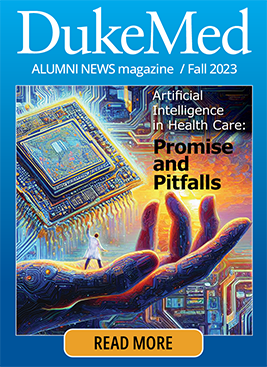
Erich Huang, PhD’02, MD’03, HS’03-’08, is head of clinical informatics at Verily, formerly Google Life Sciences. He has been a pathfinder since transitioning in 2016 from clinical care to biomedical informatics and later directing Duke Forge, an initiative to build a data science culture and infrastructure focused on actionable health data science across Duke University. In 2020 he was selected as Duke Health’s Chief Data Officer for Quality. Now the head of clinical informatics at Verily, formerly Google Life Sciences, his vision for the health care landscape remains centered on wielding artificial intelligence as a tool, not a replacement for the human touch.
What led you to Duke University School of Medicine, and how did that experience shape your career?
My connection to Duke started at birth; I was born at Duke Hospital. My father came to Duke for a hematology oncology fellowship, and after completing that he was the second Asian American faculty at Duke, in the 1960s. Although I initially resisted medicine, I inevitably followed the path, and being at Duke during its transformation in the 1970s and 1980s, when it established itself as a top medical school, was pivotal. What stood out was Duke’s approach to clinical data, not only for patient care, but also for evidence generation. There was the concept that what was done in the course of taking care of patients could ultimately turn into generalizable knowledge that would serve patients around the world. That ethos was foundational for institutes like Duke Clinical Research Institute. Growing up, I was subconsciously influenced by these developments just from hearing conversations at the dinner table.
How can data best be used to positively influence health care?
As head of clinical informatics at Verily, I think of data as an equivalent of a diagnostic or therapeutic instrument. We use data to diagnose and categorize disease or health. We use data to treat disease and maintain health. And if we think about data this way, then data should be “diagnostic-grade” or “therapeutic-grade.” In an era where we have cloud computing, application programming interfaces, and large language models with billions of parameters, we need to take a fresh look at health data and how we generate, capture, maintain, and transform it to take care of people. Medicines and devices have to meet certain standards to be used to diagnose and treat humans. There needs to be a similar rigor with which we treat data to achieve the same ends.
From starting as an assistant professor of surgery at Duke to becoming a pivotal figure in data science through Duke Forge, what inspired your shift to data science?
My PhD at Duke revolved around predicting cancer cell behaviors, using then-modern machine learning. So it was a natural next step for me to think about how to use the new electronic health record to start doing the same thing. In this case not in laboratory mice, but in how to understand human populations better. One thing you learn as a bench scientist is how important “garbage in, garbage out” is because you’re in charge of your experiment. You actually generate your own data as a bench scientist. You don’t have that opportunity when you’re using data that comes from a health record. That (experience as a bench scientist) has been a primary motivation in my career and the reason why I’ve focused on data first and algorithm second. There’s a need to develop more rigorous and uniform data practices to avoid that “garbage in” issue.
From the perspective of your former experience as Duke Health’s chief data officer and now your role at Verily in the corporate sector, how do the two environments differ?
Academia is a great place for generating ideas. It’s also a pretty good place for validation of those ideas, which is why we publish papers. But for ideas to scale in society, that is what the private sector and the world I now live in is terrific at. That’s where concepts become usable software and can therefore provide real-world benefit and societal impact.
How have algorithms and artificial intelligence affected biomedical research and patient care, and what are the challenges in using it in health care?
Algorithms have had revolutionary impact in places like the algorithm behind pulse oximetry, which has saved countless lives, especially during the COVID-19 pandemic. Yet there’s room for improvement, like addressing biases. AI is transforming sectors, and while it aids health care, it can’t replace professionals. Take navigation, for example. AI aids us in finding the quickest route, pointing out restaurants en route, and even navigating traffic. However, it doesn’t replace the human behind the wheel. I think there’s been a bit of AI hubris. The human touch, combined with AI’s precision, can revolutionize health care.
Story originally published in DukeMed Alumni News, Fall 2023.
Read more from DukeMed Alumni News
